
This article explains Sushruta Samhita Sutrasthana Chapter 15 “Doshadhatumala Kshayavruddhi Vijnaninya Adhyaya”- Knowledge of decrease and increase of dosha etc.
Now, we will expound the chapter by name Doshadhatumala Kshayavruddhi Vijnaninya – knowledge of decrease and increase of Doshas, Dhatus and Malas as revealed by venerable Dhanvantari.
Read – Decrease, Balance And Increase Of Doshas – Kshaya, Sthana, Vruddhi
Shirasaya Mulam
Foundations of the body
Doshas, Dhatus and Malas are the roots (root causes for the existence) of the body. Therefore, I would explain the symptoms (features) of these (doshas, dhatus and malas) in this context, hence listen carefully to their features.
Notes:-
Doshas are three in number, they are –
Dhatus (tissues) are seven in number, they are –
- Rasa – plasma
- Rakta – blood
- Mamsa – muscles
- Medas – fat / adipose tissue
- Asthi – bones
- Majja – bone marrow,
- Shukra – semen / reproductive tissue
Apart from these tissues, there are also some secondary tissues. They are called upadhatus.
Malas i.e., excretory or waste products are three in number –
1. Dosha
Among these, the vayu (vata) renders five main functions in the body, they are –
- Praspandana – movement
- Udvahana – perception
- Purana – filling
- Viveka – separation and
- Dharana – retaining
The vayu which is involved in these functions is divided into five divisions (types, subtypes) and supports the body (and all functions going on in the body).
Read – Types Of Doshas And Their Functions
Master Dalhana, the commentator of Sushruta Samhita has assigned each of the above-mentioned functions to one subtype of vata. They are –
| Sl No | Function of vata | Meaning | Type of vata involved |
| 1 | Praspandana | Movement – all kinds of movement of every part of the body | Vyana Vata |
| 2 | Udvahana | Perception – sensory perception (receiving, understanding and perceiving the sense objects by their respective sense organs) | Udana Vata |
| 3 | Purana | Filling – filling the body with food | Prana Vata |
| 4 | Viveka | Separation – helping in the process of digestion of food and separating its essence and wastes | Samana Vata |
| 5 | Dharana | Retention – retaining the wastes for some time and then eliminating them later | Apana Vata |
The above mentioned are the chief functions of the mentioned vata types. There are many other functions contributory to vata when it is in a state of balance / normalcy.
Pitta
The pitta renders five main functions in the body, they are –
- Raga – imparting redness,
- Pakti – cooking / digestion of food
- Teja – vision
- Medha – intelligence
- Ushma – heat, body temperature
The pitta which is involved in these functions is divided into five divisions (types, subtypes) and supports the body by its ‘agni karma’ i.e., fire like action.
Read – Pitta Dosha – General Introduction
Each of the above-mentioned functions have been assigned to one subtype of pitta. They are –
| Sl No | Function of pitta | Meaning | Type of pitta involved |
| 1 | Raga | Red colour – Imparting red colour or redness (here mainly to the rasa tissue in the liver and spleen and converting it into rakta – blood tissue) | Ranjaka Pitta |
| 2 | Pakti | Digestion – of food | Pachaka Pitta |
| 3 | Teja | Vision – providing vision | Alochaka Pitta |
| 4 | Medha | Intelligence – providing intelligence | Sadhaka Pitta |
| 5 | Ushma | Heat – providing heat and body temperature | Bhrajaka Pitta |
The above mentioned are the chief functions of the mentioned pitta types. There are many other functions contributory to pitta when it is in a state of balance / normalcy.
Kapha
The kapha renders five main functions in the body, they are –
- Samslesana – binding the joints
- Snehana – moistening / lubrication
- Ropana – healing
- Purana – filling
- Balasthairyakara – giving strength and stability
The kapha which is involved in these functions is divided into five divisions (types, subtypes) and supports the body by its ‘udaka karma’ i.e., water like action.
Read – Kapha Dosha – General introduction
Each of the above-mentioned functions have been assigned to one subtype of kapha. They are –
| Sl No | Function of kapha | Meaning | Type of kapha involved |
| 1 | Samsleshana | Binding – the joints / keeping the joints of the body tight, firm and strong | Shlesaka Kapha |
| 2 | Snehana | Moistening / lubrication – of food | Kledaka Kapha |
| 3 | Ropana | Healing and perception of taste | Ropaka Kapha / Bodhaka Kapha |
| 4 | Purana | Filling – the sense organs and head | Tarpaka Kapha |
| 5 | Balasthairyakara | Giving strength and stability and maintaining them | Avalambaka Kapha |
The above mentioned are the chief functions of the mentioned kapha types. There are many other functions contributory to kapha when it is in a state of balance / normalcy.
2. Dhatus – Primary tissues
Rasa Dhatu (plasma) – provides satisfaction (satiety), nutrition (nourishment to tissues and the whole body) and supplies nourishment to Rakta Dhatu (blood).
Rakta Dhatu (blood) – bestows (enrichment / enhancement of) colour, provides nourishment to Mamsa (muscle) and maintains life activities.
Mamsa Dhatu (Muscle) – provides nourishment to the body and also to medas (fat).
Dhatu Dhatu (fat) – bestows unctuousness / lubrication, sweating, stability and nourishment to bone(asthi).
Asthi Dhatu (bone) – provides support to the body and nourishment to majja (bone marrow).
Dhatu Dhatu (bone marrow) – provides unctuousness / lubrication, strength, nourishment of shukra (semen tissue) and fills up the bones.
Shukra Dhatu (semen / reproductive tissue) – bestows courage, ejaculation, love / affection / lust, strength of the body, pleasantness, exhilaration (sexual excitement), and the purpose of seed (formation of embryo).
Read – Dhatu – 7 Body Tissues As Explained In Ayurveda
3. Malas- waste products
Purisa (faeces) – provides support / strength and helps in the maintenance of (supports) Vayu (Vata) and Agni.
Mutra (urine) fills the urinary bladder and helps in elimination of water (moisture).
Sveda (sweat) bestows moistness and softness of the skin.
Upadhatus- Secondary tissues
Artava (female reproductive tissue- menstrual blood-ovum) – possesses the same characteristics as that of blood and helps (takes part) in the formation of the embryo.
Garbha (foetus) bestows the signs of pregnancy.
Stanya (breast milk) is responsible for the development of breasts and life (of the infant by providing nourishment).
All these (Dosha, Dhatu, Upadhatu, and Mala) should be protected (maintained normal) through appropriate methods.
Read – Upadhatus: Sub-Tissues Of The Body
Dosha Kshaya Laksana
Signs of decrease of Doshas:-
After this, we will describe the symptoms of decrease of Doshas:-
Symptoms of vata decrease– When Vata decreases (greatly), there will be –
- decrease / slowing down of / loss of activities (of the body parts),
- deficit / less of speech,
- lack of contentment / excitement and
- diminished intellect / consciousness (mental activities) etc
Symptoms of pitta decrease – When Pitta decreases, there will be –
- diminution of body heat
- diminution of digestive fire,
- loss of complexion etc
Symptoms of kapha descrease – When Kapha decreases, there will be –
- dryness,
- burning sensation inside (the alimentary canal),
- emptiness especially in the Amasya (stomach) and other seats of Kapha i.e., chest, head etc
- looseness of the joints, (thirst, debility and loss of sleep)
The methods to counter this i.e., decrease of doshas includes the use of things like foods, drinks and activities etc which would increase these doshas (and hence bring them to balance).
Dhatu Kshaya Lakshana
Signs of decrease of Dhatu
Rasa Kshaya (decrease of Rasa Dhatu – plasma) – produces pain, tremors / throbbing and emptiness of the heart; thirst etc.
Sonita Kshaya (decrease of Rakta / blood) – produces roughness of the skin, craving (desire) for sour and cold things, looseness of the veins (emptiness of the blood vessels) etc.
Decrease of Mamsa (muscle tissue) – produces dryness (wasting) of buttocks, cheeks, lips, penis, thighs, chest, axillae, calves, abdomen and neck; dryness, pricking pain, debility of the body, looseness (loss of tone) of the arteries etc.
Decrease of Medas (fat tissue) – gives rise to enlargement of Pliha (spleen), feeling of emptiness of the joints, dryness and craving for fatty meat etc.
Decrease of Asthi (bone tissue) – gives rise to pain in the bone, breaking of the teeth and nails, dryness etc.
Decrease of Majja (bone marrow) – leads to decrease in quantity of semen, splitting pain in the small joints of the hands and feet (inter-phalangeal joints), throbbing (pricking) pain in the bones, and feeling of emptiness in the bones etc.
Decrease of Shukra (semen) – leads to pain in the penis and scrotum (testes), loss of capacity to perform sex (intercourse), delayed ejaculation of semen during sex, and presence of little blood and little semen in the ejaculate.
Even for these (decrease of tissues) counter measures (treatments) are use of things (food, drink and activities) which cause their increase (things which increase the doshas).
Read – Decrease Of Tissues – Dhatu Kshaya – Reasoning, Symptoms
Mala Kshaya
Decrease of wastes
Decrease of Purisa (faces) – causes pain (discomfort) in the region of the heart and flanks, upward movement of air (flatus) accompanied with sound and movement of air in the kukshi (abdomen, epigastrium) etc.
Decrease of Mutra (urine) – causes pain in the urinary bladder and less production and elimination of urine (scanty urination).
Even for these (decrease of excreta / wastes) use of things (food, drinks etc) which cause their increase is the treatment.
Decrease of Sveda (sweat) – causes obstruction of hair follicles, dryness of skin, abnormalities of touch (tactile sensation) and absence of sweating etc. For this condition, the treatment includes massage with herbal oils (oil bath) and sudation.
Read – Tri Malas – The Three Major Waste Matters Of Body
Upadhatu Kshaya
Decrease of secondary tissues:-
Decrease of Artava (menstrual fluid) – gives rise to the below mentioned symptoms –
- menstruation (menstrual blood) does not appear at the appropriate time
- scanty menstruation (deficit flow of blood during menstruation) even if menstruation occurs
- pain in the vagina etc
Treatment – includes purification of the body (by administration of panchakarma therapies including purgation and herbal enemas given through urinary / vaginal passages) and use of things i.e., foods, drinks and medicines which are ajgneya i.e., fiery (possess fire like qualities) in nature, in a suitable manner.
Decrease of Stanya (breast milk) – gives rise to laxity (sag) and wrinkles of the breasts, non-production or scanty production of breast milk etc.
Treatment – of this condition includes use of things i.e., foods, drinks and herbs which cause an increase of sleshma (kapha).
Decrease of Garbha (embryo/ foetus) – gives rise to absence of movement of the foetus (inside the abdomen), non-enlargement of the abdomen (of the mother) etc.
Treatment – of this condition includes administration of ksirabasti (milk enema) at the appropriate time (8th month of pregnancy) and use of fatty foods.
Read – Upadhatus: Sub-Tissues Of The Body
Dosha Vriddhi
Symptoms of increase of Dosha
Further on we will describe the signs and symptoms of great increase of Dosha, Dhatu and Mala. Such an increase occurs due to over-indulgence in things (food, drink, activities etc) which causes their increase.
Vata Vruddhi – Great increase of Vata, gives rise to harshness (hoarseness) of speech, emaciation of the body, blackish discolouration of the body / body parts, throbbing in the body parts, desire for warm things and comforts, loss of sleep, less (poor) strength and hardness of faeces.
Pitta Vruddhi – Great increase of Pitta gives rise to the appearance of yellowish discolouration of the skin or seeing all objects in and around as being yellow in colour, increased heat in the body, desire for cold things (foods, activities etc) and comforts, diminished sleep, fainting, loss of strength, weakness of sense organs, yellowish colouration of faeces, urine and eyes etc.
Sleshma / Kapha Vruddhi – Great increase of Slesma (Kapha) gives rise to whitish discolouration of the body parts, coldness in the body parts, stability / stillness (absence of movements), feeling of heaviness, weakness of the body and mind (debility), stupor, excessive sleep and looseness of joints and bones in the body etc.
Read – Vruddhi Causes, Types, Symptoms, Prognosis, Ayurvedic treatment
Dhatu Vriddhi
Symptoms of increase of tissues
Rasa Dhatu Vruddhi -Great increase of Rasa Dhatu (plasma) causes oppression / discomfort in the region of the heart (nausea), and increased salivation etc.
Rakta Dhatu Vruddhi – Great increase of Rakta (blood) produces reddish colouration of the body and eyes and fullness of veins (blood vessels).
Mamsa Dhatu Vruddhi – Great increase of Mamsa (muscle) produces increase in size of buttocks, cheeks, lips, penis, thighs, arms and calves and also heaviness of the body etc.
Meda Dhatu Vruddhi – Great increase of Meda (fat, adipose) produces unctuousness of the body parts, increase in size of the abdomen and flanks, cough, dyspnoea and foul smell of the body.
Asthi Dhatu Vruddhi – Great increase of Asthi (bone tissue) produces development of bones over the bones (extra bone formation, bone tumours) and extra teeth (malformation of teeth) etc.
Majja Dhatu Vruddhi – Great increase of Majja (bone marrow) produces heaviness of the entire body and of the eyes.
Shukra Dhatu Vruddhi – Great increase of Shukra (semen) produces seminal calculus, excess production and elimination (of semen) etc.
Read – Increase And Vitiation Of Tissues – Dhatu Vruddhi
Mala Vriddhi
Increase of waste
Purisa Vruddhi – Great increase of Purisa (faeces) gives rise to flatulence and sounds in the abdomen and pain in the abdomen.
Mutra Vruddhi – Great increase of Mutra (urine), increased frequency of urination, pain and distension of the urinary bladder etc.
Sveda Vruddhi – Great increase of Sveda (sweat) gives rise to bad smell of the skin, itching etc.
Upadhatu Vriddhi
Increase of secondary tissues
Artava Vruddhi – Great increase of Artava (menstrual blood) produces body aches, flow of more quantity of blood during menstruation (severe bleeding), and bad smell etc.
Stanya Vruddhi – Great increase of Stanya (breast milk) causes increase in size of the breasts, frequent discharge of (flow of) breast milk and pricking pain in the breast etc.
Garbha Vruddhi – Great increase of Grabha (fetus) produces enormous enlargement of the abdomen and increased perspiration etc.
As a treatment for these conditions, purificatory and palliative treatments, which are not against their decrease, are to be administered.
Read – Upadhatu Of Rasa Dhatu – Stanya, Arthava: Sub Tissues Of Rasa
Reasons to cause depletion of increased tissues
Great increase of the preceding Dhatus causes great increase of its succeeding Dhatu. Therefore, it is important and beneficial to bring about depletion (decrease, mitigation) of the tissues which have undergone great increase.
Bala and Ojas
Features of Ojas
Further on, we will describe the features of Bala i.e., strength and Bala Kshaya i.e., loss of strength.
That essence of the Dhatus commencing from rasa and ending with Shukra (semen) is known as Ojas and that itself is bala (strength- thing responsible for strength) according to our science.
Strength bestows stability and growth of muscles. The person would get the ability to perform all activities without any hindrance, and will have purity (pleasantness, clarity) of voice and (brightness of) colour / complexion. The external and internal sense organs would get the ability to perform their own functions and will get indulged in the same.
Notes:- External sense organs mean Karmendriyas or Motor organs (hands, feet, pharynx, penis and anus) and internal sense organs means Jnanendriyas or sensory organs (eyes, ears, tongue, nose and skin) and also Manas (mind) which is both karmendriya as well as jnanendriya.
Read – What is Ojas? How To Increase Ojas During Health And Disease?
Ojas Lakshana
Characteristic features and functions of Ojas
Ojas is moon like (coolant) in properties, unctuous, white in colour, cold in potency, stable, moving forth (free flow), clear, soft, and is the chief among the seats of life. The ojus pervades the entire body along with all its organs. In its absence the body of the living beings would perish.
Ojas Kshaya Karana
Causes for decreases of Ojas and symptoms
Ojas undergoes decrease due to injury (to the body), loss of tissues, anger, grief, worry, exertion, and hunger (etc). Then this tejas (ojus) being instigated by vata flows out (leaks out) from the dhatugrahana i.e., srotas (channels which receive and transport the tissues) will hamper the body of its normal functioning (troubles the body in a great way).
Three abnormalities of ojas
Visramsa,Vyapat and Kshaya are its (decrease of Ojas) three abnormalities (stages of decrease). The symptoms of these are as follows:-
Ojo visramsa (first stage) – In this stage there occurs
- looseness of the joints
- weakness of the body
- displacement of the Doshas, (vata, Pitta and Kapha from their normal seats) and
- hindrance to all movements
Ojo Vyapat (second stage) – In this stage there occurs
- stiffness of the body
- heaviness of the body,
- oedema caused by Vata,
- discoloration,
- exhaustion,
- stupor and
- excessive sleep
Ojo Kshaya (third stage) – In this stage occurs,
- fainting,
- loss or decrease of muscles (emaciation),
- ignorance, bewilderment, delusion
- delirium and
- death
Also,
Some verses here:-
Vyapat, visrama and Kshaya are the three abnormalities of bala (ojas). Symptoms of Bala Visramsa – are loosens of joints, debility of the body, displacement of tridoshas, fatigue, improper execution of movements.
Symptoms of Bala Vyapad – are feeling heaviness and stiffness of the body (body parts), exhaustion, discoloration, stupor, sleep and oedema of vata origin.
Symptoms of Bala Kshaya – are fainting, loss / decrease of muscles (emaciation), delusion, delirium, ignorance, symptoms mentioned earlier and death.
Read – Prana, Tejas and Ojas – Subtle Forms of Tridoshas
Treatment of abnormalities of ojus
During Visramsa and Vyapat stages, bala / ojas should be enhanced (increased) by adopting treatments which are not opposite to bala, dosha and agni. The other one (Kshaya stage) producing improperunderstanding (or unconsciousness) should be refused treatment (the patient of oja kshaya having unconsciousness should not be treated).
The person who has a decrease of Doshas, Dhatus, Malas or even bala (ojas) develops a desire for foods and drinks which make for their increase (which have similar qualities and hence bring about their increase). When the person suffering from depletion of dhatus desires to have particular foods, and when the desire is fulfilled (by giving the desired foods), (the given foods) will ward off the depletion of related dhatus and bring them to a state of normalcy.
Those patients in whom the vayu has abnormally increased due to the depletion of dhatus and has caused loss of consciousness and functions, and also decrease of strength, cannot be treated at all.
Notes:- Ojas is a substance present in every Dhatu (tissue). It is considered as the essence of the tissues which is responsible for the strength of the body.
The other texts describe 2 kinds of ojas. They are –
- Para Ojas (chief ojas) – Its quantity is eight drops. It is located in the hrdaya i.e., heart. Its decrease or loss leads to grave diseases and sometimes death.
- Apara Ojas (secondary ojas) – It is also known as shleshmika ojas (due to its similarities in properties with slesma – kapha). Its quantity is half anjali (80ml approximately). This type of ojas is present in all the tissues. This is considered as the essence of dhatus and responsible for strength. Decrease of this type of ojas gives rise to diminution or absence of strength in the body.
The three stages of decrease of ojus have been explained in relation to this apara ojas. Chakrapani (Commentary on Charaka Samhita Sutra 28/7) explains bala as vyadhi kshamatva (capacity to tolerate the diseases – immunity), vyadhibala virodhitva (capacity to oppose the strength of the disease).
Read – Charaka Vatavyadhi Chikitsa 28th Chapter
Sthaulya and Karshya
Corpulence (obesity) and emaciation
Sthaulya(corpulence) and Karsya(emaciation) are due to rasa Dhatu itself
Sthaulya – Corpulence
Causes
- Excessive indulgence (for long periods) in kapha increasing foods,
- Those habituated to eat large quantities of food, often
- Those who are not indulged in any kinds of physical activities (sedentary and relaxed life)
- Those who are habituated to sleeping during day time etc.
In people who are indulged in the above-mentioned etiological factors, the food remains inadequately digested (uncooked). This uncooked (ama) food having excessive sweetness will circulate in the entire body and due to its excessive unctuousness, it will cause an increase of medas (fat). This excessively formed fat causes too much corpulence of the body (obesity).
Read – Obesity: Pathology, Signs And Symptoms As Per Ayurveda
Symptoms of Atisthula – The person suffering from obesity will have the below mentioned symptoms –
- Mild dyspnoea
- Thirst
- Excessive hunger,
- Excessive sleep (sleepiness)
- Excessive sweating,
- Bad smell from the body
- Indistinct sounds from the throat / Snoring (sounds from the throat while at sleep)
- Debility of the body,
- Stammering
Because of the softness of the fat, the obese person would become incapable of doing any activities. The person becomes poor in capacity copulation since his channels of semen are obstructed by vitiated kapha or fat. Because of the obstruction of the srotas (channels of other tissues) the remaining tissues will not receive sufficient nourishment which in turn makes the person poor in all the life activities (reduced longevity). Due to this the person becomes affected by diabetes, eruptions, fever, rectal abscess, vata disorders and many such diseases and will eventually face death. Due to the obstruction of all the channels by the increased fat, all the diseases would become powerful. As a result one should (in this condition) avoid all the causes which tend to increase fat tissue and cause obesity.
On the contrary if obesity has already developed one should make use of shalajatu, guggulu, gomutra, triphala, loha bhasma, rasanjana, madhu, yava, mudga, koradusaka, syamaka, uddalaka etc. things which would cause dryness and clear the obstructed channels (by separating the blocks) according to the stipulated procedure. One should also indulge in exercises and undergo Lekhana Vasti (scarifying / scraping enemas) etc.
Karshya – emaciation
Causes
- Excessive indulgence in (for long periods) foods which cause vata increase
- Excessive exercise,
- Excessive indulgence in copulation,
- Fear, grief, worry in excess
- Habituated to keeping awake at night times,
- Thirst, hunger (suppression of thirst and hunger),
- Excessive use of astringent things (foods having astringent taste),
- Consumption of too less food
When the person consumes the above said etiological factors, the rasa dhatu gets dried up and hence will not be capable of nourishing the body in a proper and adequate way. This will lead to profound emaciation of the persons.
Symptoms of emaciation – The person who is extremely emaciated due to consumption of the above said etiological factors he will suffer from the below mentioned symptoms –
- Incapable of tolerating hunger, thirst, cold, heat, breeze, rain and carrying heavy weights,
- Dyspnea, cough,
- Consumption,
- Enlargement of spleen,
- Enlargement of abdomen,
- Weakness of digestive power,
- Abdominal tumour,
- Bleeding disorders
The person would suffer from one or the other of the above-mentioned symptoms and eventually will face death. All diseases occurring in these (severely emaciated) persons will be severe because of his poor strength.
Hence, he should avoid all causes which produce this condition.
If the person has already developed severe emaciation, he should use payasya, asvagandha, vidarigandha, satavari, bala, atibala, nagabala and other drugs which are sweet, according to the stipulated procedure. Apart from these, milk, curd, ghee, meat, Sali, sastika, Yava and Godhuma, shall be taken. One should also indulge in day sleep, celibacy, not doing any physical exercise and also should resort to brmhana basti (nutritive enema).
Madhya Sarira- Medium physique
He who consumes foods which are moderate in both properties viz, unctuousness and dryness (non-unctuousness), the essence of food that gets formed in him, circulates throughout the body, and will cause nourishment or growth of tissues in equal proportions (properly). These persons would have balanced tissues and a medium sized body and will hence be capable of performing all the activities. He will tolerate (have endurance towards) hunger, thirst, cold, heat, breeze, rain and sunlight and will also be strong. Such a condition should be maintained constantly.
Another verse here-
Both these persons, the obese and the emaciated – are to be deprecated always, that of medium physique is best; between the obese and the emaciated is better.
Sanskrit Verses
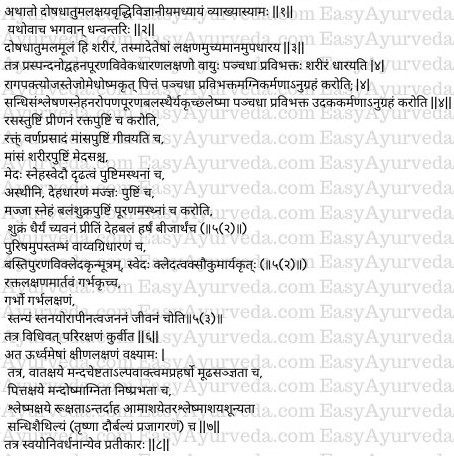
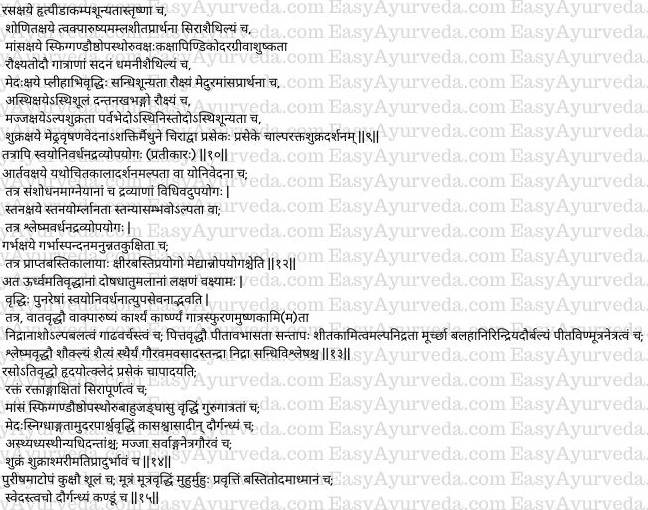
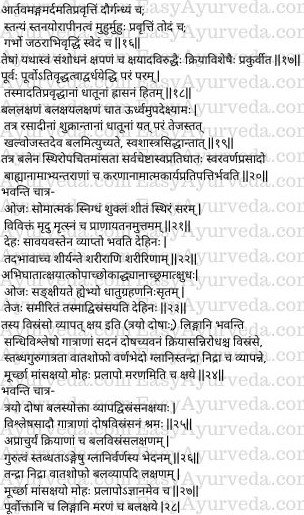
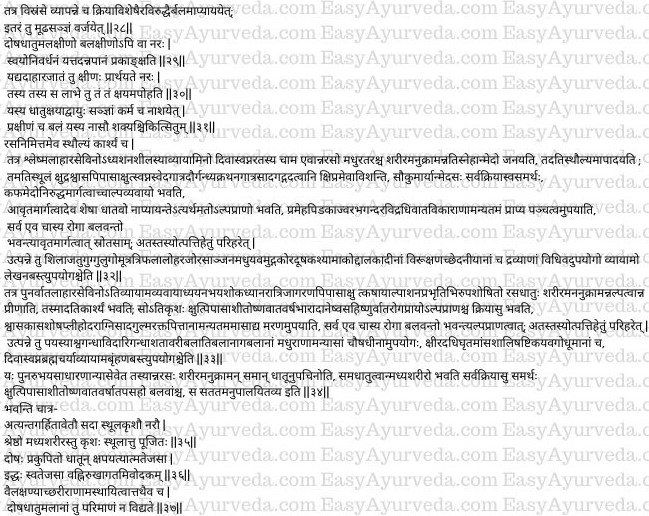
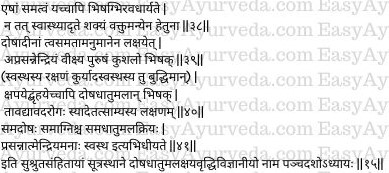
Dosha Prabhava
Effect of Doshas
Doshas, when aggravated (increased greatly) bring about decrease / diminution of the Dhatus by their own strength, just as fire when augmented evaporates the water in the pot by its own power.
Dosha dhatu pramana
Quantity of Doshas and dhatus
Body (of persons) being different in its features (from one person to the other) and also being unstable, the quantity of the Doshas, Dhatus and Malas cannot be stated (accurately).
Read – Anjali Pramana: Volume Measurement As Per Ayurveda
Balance of doshas etc is a status of health
The normality of these doshas, dhatus and malas , what so ever, understood and described by the physicians cannot be explained by any other causes (factors) other than health (i.e., the normalcy or balance of these things is nothing but health).
Inference of abnormalities (imbalances) of doshas etc
The abnormalities of dosha etc. should be inferred by the intelligent physician, by observing the aprassanna indriyatvam i.e., unclear conditions of the sense organs (body and mind).
The intelligent physician should always try to protect the healthy person. In case of unhealthy persons, the Doshas, Dhatus and malas which have undergone increase or decrease should be reduced or increased respectively till the person becomes free from diseases (or abnormal symptoms) and that is the feature of normal.
Svastha purusha
Healthy person
He, in whom the Doshas, agni (digestive power), Dhatu (tissues), Malas (waste products) and their activities are normal; his soul, sense organs and mild are calm / clear, is called “Svastha (healthy person)”.
Thus end the Fifteenth chapter by name Doshada Tumala Ksa Vruddhi Vijnaniya in Sutra Sthana of Susruta Samhita.








